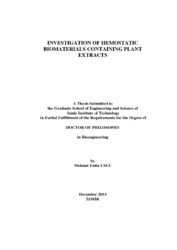Please use this identifier to cite or link to this item:
https://hdl.handle.net/11147/4302| Title: | Investigation of Hemostatic Biomaterials Containing Plant Extracts | Other Titles: | Bitki Özütleri İçeren Hemostatik Biyomalzemelerin Araştırılması | Authors: | Uslu, Mehmet Emin | Advisors: | Bayraktar, Oğuz Başal Bayraktar, Güldemet Akhisaroğlu, Mustafa |
Keywords: | Equisetum arvense Haemostasis Biomaterials |
Publisher: | Izmir Institute of Technology | Source: | Uslu, M. E. (2014). Investigation of hemostatic biomaterials containing plant extracts. Unpublished doctoral dissertation, İzmir Institute of Technology, İzmir, Turkey | Abstract: | Haemostasis in other words a process which causes bleeding to stop is very important in injury. Recent researches were focused on discovery of haemostatic agents and developing biomaterials which transfer them to the injury side. Therefore plant extracts and three dimensional biomaterials were widely investigated. In this research the extract of Equisetum arvense was investigated as a coagulatory agent. Silk fibroin-hyaluronic acid mixture was used for the preparation of three dimensional sponge like biomaterials. The prepared sponge forms could also be used as scaffold for wound healing. In this research effect of extraction parameters on extract composition and bioactivity was investigated. Effect of extraction parameters were analyzed on 6 factors at 3 levels. It was seen that extraction parameters had high influence on both composition and bioactivity of the prepared extract. Although it was reported that the extract of equisetum arvense had anticoagulant activity, in this research it was shown that changing parameters caused variation of extract bioactivity from anticoagulant to coagulant as a result of changing extract composition. Addition of extract into silk fibroin-hyaluronic acid mixture caused proteins to precipitate as a result of interaction between protein and phenolic compounds. As a result of this precipitation significant decrease in the mechanical strength of biomaterial was observed. In order to minimize this interaction, plant extract was added into the silk fibroin after mixing with hyaluronic acid solution. As a result, mechanical strength and pore size of the biomaterial were increased and pore distribution became more regular. Also biomaterial gained tubular network on both vertical and horizontal dimensions. This would help the proliferation and migration of the fibroblast cells and moreover prevent the formation of scar tissue. | Description: | Thesis (Doctoral)--İzmir Institute of Technology, Bioengineering, İzmir, 2014 Full text release delayed at author's request until 2018.01.20 Includes bibliographical references (leaves: 67-71) Text in English; Abstract: Turkish and English xi, 71 leaves |
URI: | http://hdl.handle.net/11147/4302 |
| Appears in Collections: | Phd Degree / Doktora |
Files in This Item:
| File | Description | Size | Format | |
|---|---|---|---|---|
| T001330.pdf | DoctoralThesis | 2.65 MB | Adobe PDF |  View/Open |
CORE Recommender
Page view(s)
298
checked on Mar 10, 2025
Download(s)
176
checked on Mar 10, 2025
Google ScholarTM
Check
Items in GCRIS Repository are protected by copyright, with all rights reserved, unless otherwise indicated.